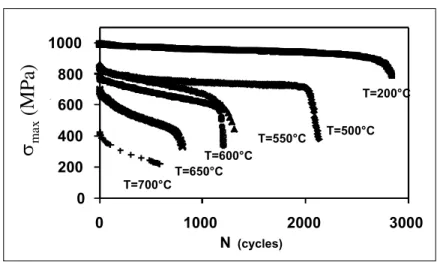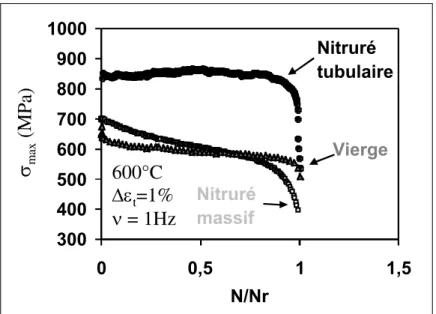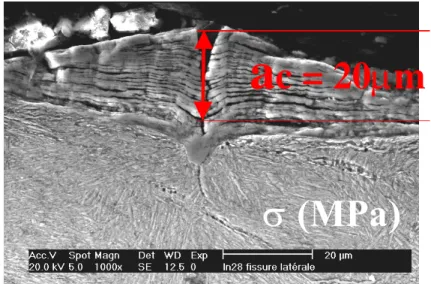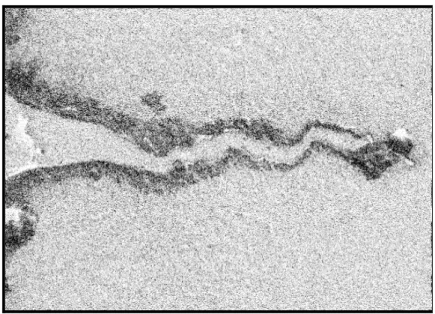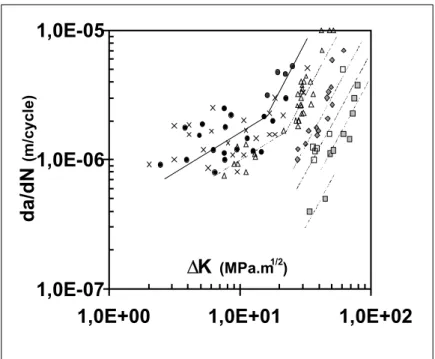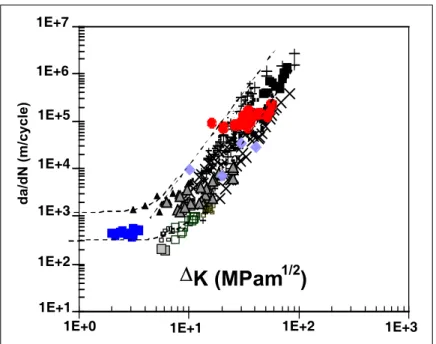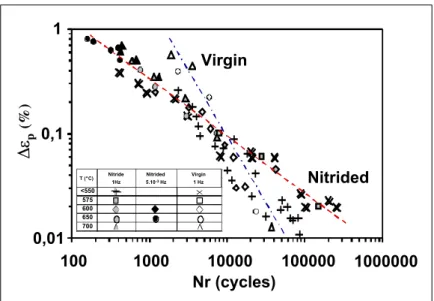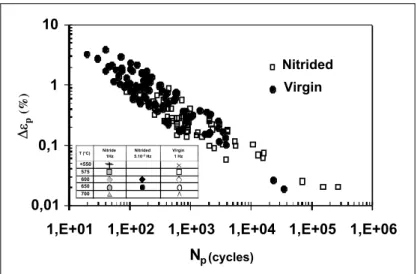Fatigue–oxidation interaction models for life
prediction of hot-forming tools steels under transient
thermomechanical loadings
C. Daffos
Aubert & Duval – Usine de Pamiers
75bld de la libération – BP 73 – 09 102 Pamiers cedex, France E-mail: daffos@aubertduval.fr
P. Lamesle* and F. Rézaï-Aria
Tools Surface Investigations UnitsCROMeP, Ecole Mines Albi, Toulouse University Route de Teillet
81013 Albi cedex 09, France E-mail: lamesle@enstimac.fr E-mail: rezai@enstimac.fr *Corresponding author
Abstract: This contribution deals with the life prediction of the virgin and
nitrided hot-working tool steels X38CrMoV5 (AISI H11, 47 HRC) under Transient Thermomechanical (TMF) loading. Isothermal Low Cycle Fatigue (LCF) and thermomechanical (TMF) behaviour are investigated at different temperatures and various frequencies. It is shown that nitruration can enhance the fatigue life only when the strain amplitude is lower than a critical value. Two Manson-Coffin laws govern the fatigue life of the virgin and nitrided steels for all temperatures and strain rates investigated. However, these models have shortcomings for predicting TMF life. Predictive fatigue life models take into account the interaction with oxidation. Regarding the second tempering temperature (550°C) and the steel surface (virgin or nitrided), a Paris-type (T > 550°C) or a Tomkins-type (T < 550°C) law is used. A modified Tomkins model considering the mean residual stress measured by X-Ray at high temperature in the nitrided layer is used. The model is applied for isothermal and thermal mechanical fatigue experiments performed and reported in literature.
Keywords: high-temperature fatigue-oxidation; life prediction; nitriding steels;
hot-forming tools.
Reference to this paper should be made as follows: Daffos, C., Lamesle, P. and
Rézaï-Aria, F. (2008) ‘Fatigue–oxidation interaction models for life prediction of hot-forming tools steels under transient thermomechanical loadings’, Int. J. Microstructure and Materials Properties, Vol. 3, Nos. 2/3, pp.350–362.
Biographical notes: C. Daffos received his PhD from INSA Toulouse in 2004.
This work was done during his PhD studies. He is currently a Metallurgical Engineer at Aubert & Duval Company.
P. Lamesle is an Associate Professor of Metallurgy and Materials Chemistry at Ecole des Mines d’Albi, France. He received his PhD in Materials Science in 1995 from Henri Poincaré’s University of Nancy. His current research focuses on degradation of metallic materials and optimisation of materials by heat treatment and surface treatment.
F. Rézaï-Aria received his BSc from the Metallurgy Department of Sharif University of Technology, Iran and his MSc and Doctor ès Sciences (1986) at the Materials Centre at École des Mines de Paris, France. As Assistant Professor, he headed for eight years the High Temperature Fatigue Group at the Mechanical Metallurgy Laboratory (headed by Professor B. Ilschner), in the Swiss Federal Institute of Technology. He is currently a full Professor of Materials Science and the Head of Tool Surface Investigations Research Unit at CROMeP, Ecole des Mines d’Albi, France. He is the author and co-author of more than 100 papers. He is a member of the Burro of the French Fatigue Committee of SF2M, and Co-chairman of the Working Group on Thermal Fatigue of SF2M in France.
1 Introduction
The surface of hot-forming tools is a special area for damage accumulation and thus a limiting factor in the life of tools. The surface of tools is extremely solicited and damaged under wear–fatigue–oxidation interactions (Rézaï-Aria, 2002). It is thus necessary to get better insight into the damage mechanisms under cyclic transient thermal and mechanical loadings. The surface of the forging tools are in most cases nitrided in order to reinforce the surface tools. The nitruration consists in introducing the nitrogen on the surface of steels by appropriate thermochemical treatments (Daffos, 2004). Depending on the process and treatment conditions (time, temperature, etc.) two layers can be observed. On the extreme surface of tool steels a layer of about 15 µm thickness (white layer) with a hexagonal compact crystallographic structure and a second layer of about 250 µm (diffusion layer) are formed. Different carbo-nitrides with different crystallographic structures are formed. Very limited investigation has been devoted to the fatigue behaviour of 5% CrMoV-nitrided steels, widely used in forging for example. It is already reported that the oxidation plays an important role for crack initiation and propagation. Very little is known about the role of the nitride layer/oxidation interactions on fatigue behaviour and life. Within the framework of the French programme, SIMULFORGE, life-predictive models for transient thermal-mechanical loading were developed. This project was a national project with the forging industry and academic partners (with financial support from the French Ministry of Industry). Its goal was to develop new simulation tools for the optimisation of the forging process taking into account the parameters of the material (metallurgy, residual stress, heat treatments, etc.). This contribution deals with an investigation on high-temperature isothermal LCF behaviour and fatigue life prediction of a nitrided and virgin X38CrMoV5 (47 HRC). Isothermal LCF tests have been performed at temperatures ranging from 200°C to 700°C. Crack initiation and propagation mechanisms are studied by SEM. Oxidation kinetics on surface and on crack lips are also assessed.
2 Experiments and material
2.1 Material
A double-tempered martensitic steel X38CrMoV5 (AISI H11) with 47 HRC is investigated. Its composition, as shown in Table 1, and microstructure are investigated in Siaut (1994).
Table 1 Chemical composition of X38CrMoV5
Chem. Elt. C Cr Ni Mn Si V Mo Other Fe
Wt% 0,4 5 0,2 0,5 0,9 0,5 1,2 2 bl.
Complex nitrided layer of 200 to 230 µm thickness is deposited by NH3 gas cracking for 12 hours at 550°C. Metallographic investigations have shown that carbonitrides are precipitated parallel to the diffusion front of the nitrogen during the nitriding process (Daffos, 2004). It should be noted that the nitrided layer is actually not a monolithic but a gradient material in terms of its chemical composition and crystallographic structures (Barrallier, 1992). Moreover, one part of the nitrogen atom is consumed in chromium precipitates (Barrallier, 1992).
2.2 Experiments
Fatigue experiments are performed on a push–pull closed loop servo hydraulic machine (Schenk 250kN). The specimens are heated by a 2 kW induction facility (100–400 kHz). Solid specimens with 11 mm diameters are used. Gauge lengths are mechanically polished down to 1 µm. Temperature is measured by three flattened thermocouples pulled by springs on the gauge. Total strain is monitored by a high-temperature extensometer. The temperature and strain amplitude ranges are from 200°C to 700°C and from 0.4% to 1.2%, respectively. Most of the experiments are performed under 1Hz frequency, but 0.004Hz and 0.05Hz are also tested.
The fatigue striations observed on the fracture surface are used for evaluation of crack propagation rate.
3 Results and discussions
3.1 Cyclic behaviour
Both nitrided and virgin steels soften under LCF conditions. The softening is observed under isothermal LCF, thermomechanical (Delagnes et al., 1999) and thermal fatigue (Miquel, 1998) for virgin steel. Two softening regimes and a third regime corresponding to the macro crack propagation are reported (Delagnes et al., 1999). The softening is explained by material accommodation owing to microstructure evolutions (dislocation density and arrangement). Such accommodations are reported on different tempered martensitic and ferrite-martensitic duplex steels (Rousseau et al., 1975; Filacchioni et al., 2000). The effect of the temperature (from 200°C to 700°C) on cyclic softening is reported in Figure 1 as the reduction of the stress amplitude versus cycles.
Figure 1 Cyclic softening of nitrided steel as a temperature function
The cyclic softening increases when the frequency decreases (example, 650°C and total strain amplitude of 1%) (see Figure 2).
Figure 2 Cyclic softening of nitrided steel as a frequency function
The cyclic softening is similar in virgin and nitrided steels when solid specimens are used. In fact, the nitrided surface supporting the applied load is small in comparison to the virgin part. Therefore the macroscopic (or global) behaviour is not drastically altered in comparison to virgin steel. A very similar softening trend is observed on the virgin tubular specimen in comparison to the solid specimens. On the contrary, in a nitrided steel tubular specimen with an approximately 40% to 50% of the total wall covered by the nitrided layer, cyclic softening is no longer similar to the solid specimen
0 200 400 600 800 1000 0 1000 2000 3000 N (cycles) ?max (MP a) T=200°C T=500°C T=550°C T=600°C T=650°C T=700°C
σ
ma x(
M
Pa
)
0
100
200
300
400
500
600
700
800
0
200
400
600
800
N
(cycles)?
max (Mpa ) f=1 Hz f=5.10-2 Hz f=4.10-3 Hz??
t=1%
T=650°C
σ
max(
M
Pa
)
∆ε
t=1%
(see Figure 3). Under 1 Hz frequency, no softening is observed, while under 0.004 Hz, softening is observed. This experimental evidence, shows the drastic modification that the nitrided layer can exert on the local (microscopic) behaviour and softening of the steel. When the frequency is low, the virgin steel presents a higher inelastic behaviour and thus the softening is seen in tubular specimen.
Figure 3 Comparison between virgin and nitrided massive specimen and nitrided
tubular specimen
3.2 Crack initiation modelling
Based on cross-section observations, the crack initiation is modelled considering fatigue oxidation interactions. The crack initiation mechanisms of nitrided steel are different depending on whether temperature is higher or lower than 550°C.
Beyond 550°C, cracks are decorated by stratification of the oxide layer (Daffos et al., 2002) as shown in Figure 4. Such oxidation aspect was already reported for low chromium steel contents (Sehitoglu, 1990). The critical length of the crack is given by the following equation: nitrided c oxide c t a t δ = ⋅ with N t v =
where N is the number of cycles and ν is the frequency of the cycle.
300
400
500
600
700
800
900
1000
0
0,5
1
1,5
N/Nr
?
ma x (MPa)600°C
??
t=1%
?=1Hz
Vierge
Nitruré
massif
Nitruré
tubulaire
600°C
∆ε
t=1%
ν = 1Hz
σ
max(
M
Pa
)
By this way, the number of cycles to initiate a wedged micro crack of about 20 µm depth is estimated: . . c a nitrided c oxide a N υ t δ = with exp . . nitrided oxide c Q K t RT δ = ⎛⎜− ⎞⎟ ⎝ ⎠
Figure 4 SEM image of stratified micro crack
The proposed model allows the number of cycle Ni to be estimated to initiate a wedged
defect or micro crack of about 20 µm depth. It uses the oxidation kinetic constants (K and Q), the critical time tc required to break an oxide layer and the test frequency ν in the
following expression: . . exp c i c a N t Q K RT υ = − ⎛ ⎞ ⎜ ⎟ ⎝ ⎠
Nitrided layer cracks are fulfilled with the stratified oxide layers and crack lips are decorated with Cr-depleted zone. Such oxidation/fatigue interaction and the relative material alteration are frequently reported in the literature (Remy, 1996). Figure 5 shows the affected zone near the crack with oxygen. The relation between the thickness of this oxided zone and the crack length was used for calculating the number of cycles required for a crack to propagate through the nitrided layer (Daffos, 2004). A constant mean fatigue crack propagation rate of about 2.8 µm per cycle was estimated in nitrided layer ranging from 20 µm to 300 µm (temperature beyond 550°C). No such oxidation mechanism was observed in virgin steel cracking.
σ (MPa)
Figure 5 X-ray element map of oxygen of affected zone near crack edge
Note: The dark area contains oxygen atoms, the white zone corresponds to nickel plating.
For temperature lower than 550°C, it is supposed that cracks are initiated through the nitrided layer at the first cycle.
3.3 Crack propagation modelling
Beyond 550°C, the fatigue striation is observed both in nitrided and virgin steel. Assuming that one striation corresponds to one cycle (Laird, 1967; Oudin, 2001), the fatigue striation spacing accounting allows estimating the crack propagation rate. A Paris law relating the crack propagation rate to the stress intensity factor (Paris and Erdogan, 1963) could be used (Figure 6):
( )
. m
glob
da C K
dN = ∆
where Cglob was divided into three corrective factors.
The oxidation and frequency effects are introduced via two first additional corrective factors Cν (frequency) and Coxi (oxidation constant) as:
1 C β ν = ⎜ ⎟α⎛ ⎞υ ⎝ ⎠ and exp . oxi Q C K RT − ⎛ ⎞ = ⎜ ⎟ ⎝ ⎠
Figure 6 Variation of cracks propagation rates as the function of stress intensity factor for our
isothermal LCF test (Paris-type law)
The third factor, Cmech is added for taking into consideration the crack opening time in
a fatigue cycle, which depends upon the loading (isothermal, or non-isothermal) and loading ratio (Daffos et al., 2002):
min max . p mech OpenTime p C ε f ε =
fOpenTime is estimated by a video microscope recording during the fatigue test.
This modified Paris law can rationalise all isothermal LCF and TMF results obtained in these investigations and those reported in the literature (Figure 7):
( )
min max 1 . oxi. p . OpenTime m. p da C f K dN β ε α υ ε ⎛ ⎞ = ⎜ ⎟ ∆ ⎝ ⎠It should be emphasised that depending upon the virgin or nitrided steel, the appropriate oxidation constant Coxi is used. Under test conditions examined, the striation accounting
for short cracks (crack length lower than 100 µm) is difficult. Therefore, for crack depth ranging between 20 µm to 1000 µm, it is assumed that the crack propagation cycle, Np,
can be estimated by this modified Paris law.
1,0E-07
1,0E-06
1,0E-05
1,0E+00
1,0E+01
1,0E+02
∆K
(MPa.m1/2)da/dN
(m
/cyc
Figure 7 Modified Paris law applied on all LCF tests presented in Figure 6
For temperature lower than 550°C, no drastic oxidation effect could be revealed and therefore, the Paris-type law is replaced with a modified Tomkins law (Tomkins, 1968):
0 0,51. sec 1 . . 2 p da a dN π σ ε σ ⎡ ⎛ ⎞ ⎤ = ∆ ⎢ ⎜ ⎟− ⎥ ⎢ ⎝ ⎠ ⎥ ⎣ ⎦
This crack propagation model uses the Tomkins’ expression based on the amplitude of plastic deformation (Daffos et al., 2002). We have used the following expression for both nitrided and virgin steel:
0 0,51. sec 1 . 2 i p da a dN σ σ π ε σ ⎡ ⎛ − ⎞ ⎤ = ∆ ⎢ ⎜ ⎟− ⎥ ⎢ ⎝ ⎠ ⎥ ⎣ ⎦
where σ0 is the yield stress of the virgin steel and σi is an internal (or residual)
stress, which is nil for virgin steel but not for nitrided steel. In fact, the nitrided layer is under internal residual stresses induced during the nitriding process (Barrallier, 1992). The internal stress is added to external stress, which leads to alteration of the crack propagation rate. The residual stress, σi is measured from the surface towards the bulk
using an X-ray diffraction method from room temperature to 550°C by successive electro polishing of the nitrided layer (Daffos et al., 2002). The residual stress in the nitrided layer is not constant and changes from the free surface towards the virgin/nitride interface. For simplification, a mean stress value of about 250 MPa is used in the modified Tomkins’ expression.
∆K (MPam
1/2)
da/dN (m/cycle) 1E+1 1E+2 1E+3 1E+4 1E+5 1E+6 1E+73.4 Fatigue life and prediction
The drastic effect of the temperature on fatigue life as a function of the total strain amplitude or as maximum stress has been discussed in Daffos et al. (2002). Based on such fatigue life criterion, a temperature dependency is clearly observed on fatigue life curves. By increasing the temperature, the LCF life decreases under a prescribed loading. It seems that the behaviour of both nitrided and virgin steel decreases drastically for temperatures higher than 550°C. In the same manner, when the test frequency is reduced, the life decreases drastically. In fact, as stress per cycle decreases, the part of the inelastic strain in the total strain is enhanced and so the LCF decreases. Therefore the fatigue life becomes frequency-dependent (Figure 2). Figure 8 presents the fatigue life curve as a function of the inelastic strain range for both virgin and nitrided conditions (at half-life). As can be observed, such fatigue life criterion is not temperature-dependent. In addition, the frequency effect also disappears. Therefore the Mason-Coffin plastic strain-based law ∆εp = C.(Nr)–α becomes a relevant criterion for isothermal LCF life prediction for
temperatures ranging from room temperature to about 700°C and the strain rate reported here. Figure 8 points out another important evidence that beyond a critical inelastic strain range, the isothermal LCF life of nitrided steels is lower than that of virgin steel.
Figure 8 Plastic strain amplitude versus fatigue life in isothermal conditions
This Manson-Coffin law was applied to predict the isothermal fatigue life of X38CrMoV5 (AISI H11) examined in this investigation and also that reported in literature. As can be expected, isothermal LCF life was fairly well predicted. However, when applied to predict the TMF life, the Manson-Coffin models present shortcomings for both nitrided and virgin steels. Figure 9 shows the relation between plastic strain amplitude and the number of propagation sample (as calculated in the previous section) is identical for nitrided and virgin steels.
0,01 0,1 1 100 1000 10000 100000 1000000 Nf (cycles) ?? p(%) Nitruré Vierge Nitrided Virgin
∆
ε
p (% ) Nr (cycles) T (°C) LCFNitruré 1Hz LCF (5.10-3Hz) LCF Vierge 1Hz <550 575 600 650 700 Symbole Virgin 1 Hz Nitrided 5.10-3 Hz Nitride 1Hz T (°C) 1000000Figure 9 Relation between fatigue life and inelastic strain range measured at half life
So the difference between the LCF life of both steels is due to their crack initiation and mechanisms. The fatigue life, Nr (= Ni + Np), covers the crack initiation (Ni) and crack
propagation (Np). Np can be estimated from the modified Paris law for temperatures beyond 550°C for both virgin and nitrided steels. It should be emphasised that, in nitrided steel, a constant propagation rate is considered for crack length ranging between 20 µm to 300 µm. The crack initiation life (Ni) is therefore calculated by Ni = Nf – Np.
For temperature lower than 550°C, it is assumed that the total fatigue life is spent in propagation and cracks initiate from the first cycle (Ni = 1). Figure 10 shows a comparison between the experimental and the calculated fatigue life for all experiences examined here and those reported from literature (in the range of factor 3) (Oudin, 2001; Samuelson, 2001).
Figure 10 Comparison between the predicted fatigue life and the experimental results obtained
from this work and literature
Sources: Oudin (2001) and Samuelson (2001) 0,01
0,1 1 10
1,E+01 1,E+02 1,E+03 1,E+04 1,E+05 1,E+06 Np(cycles) ??p (%) Nitruré Vierge ∆εp (%) Nitrided Virgin T (°C) LCFNitruré 1Hz LCF (5.10-3Hz)LCF Vierge 1Hz <550 575 600 650 700 Symbole Virgin 1 Hz Nitrided 5.10-3 Hz Nitride 1Hz T (°C)
LCF
TMF
x3
Type test Origine Motif Samuelson Larsson A. Oudin Larson A. Oudin PSA D. Delagnes TMF LCF Symbol Author Test
4 Conclusion
Isothermal and thermal-mechanical LCF fatigue life of a tempered martensitic steel, X38CrMoV5 (47 HRC), are investigated under various experiments involving virgin and nitrided conditions.
The role of the oxidation on crack initiation and propagation is examined. It is shown that oxidation plays an important role on the fatigue life of X38CrMoV5 both in nitrided and virgin conditions. It is observed that the nitriding treatment can modify the crack initiation mechanism.
Inelastic strain range is one criterion (Manson-Coffin’s law) for isothermal LCF fatigue life that is temperature- (20°C to 700°C) and frequency-independent. Two Manson-Coffin’s laws were found for nitrided and virgin steel from 20°C to 700°C. Such laws are relevant for isothermal LCF fatigue life prediction. It is observed that beyond a critical inelastic strain range, the isothermal LCF life of nitrided steels is lower than that of virgin steel. It is observed that isothermal LCF Manson-Coffin’s law presents shortcomings for prediction of the thermomechanical fatigue life (fatigue under temperature transition conditions).
The modified Paris and Tomkin’s laws are introduced for fatigue life prediction for nitrided and virgin steels by considering environment effect, frequency dependence and the mechanical loading pattern.
The fatigue life models proposed can predict isothermal LCF and TMF experiments in the range of factor 3.
Acknowledgements
This work has been partly funded by the French Ministry of Industry (SIMULFORGE Program). The authors also wish to acknowledge all partners, in particular CETIM, for their support.
References
Barrallier, L. (1992) ‘Genèse des contraintes résiduelles de nitruration Modélisation et expérimentation’, ENSAM centre d’Aix-en-Provence.
Daffos, C. (2004) ‘Endommagement des outillages de forgeage traités par Nitruration: Etude et modélisation’, PhD work, INSA Toulouse, realized at Ecole des Mines d’Albi-Carmaux. Daffos, C., Lamesle, P. and Rézaï-Aria, F. (2002) ‘Isothermal high temperature low cycle fatigue
of 5% CrMoV tool nitride steels’, High Temperature Fatigue CAMP 2002, Paderborn, Germany, pp.56–63.
Delagnes, D., Rézaï-Aria, F., Levaillant, C. and Grellier, A. (1999) ‘Influence of temperature and initial hardness on fatigue behaviour and life of a 5%Cr hot work tool steel’, Proceedings of the 5th International Conference on Tooling, pp.195–204.
Filacchioni, G., Petersen, C., Rézaï-Aria, F. and Timm, J. (2000) ‘An European round robin in thermo-mechanical fatigue behaviour of a 9% Cr low activation ferrite-martensite steel’, in H. Sehitoglu and H. Maier (Eds.) Third Symposium on Thermo-mechanical Fatigue Behaviour of Materials, ASTM STP 1371, American Society for Testing and Materials, West Conshohocken, Pennsylvania, pp.239–256.
Laird, C. (1967) ‘The influence of metallurgical structure on the mechanisms of fatigue crack propagation’, ASTM STP 425, Fatigue Crack Propagation, Philadelphia: American Society for Testing and Materials, pp.131–180.
Miquel, B. (1998) ‘Etude du comportement et de l’endommagement en fatigue thermomécanique de l’acier F82H-mod à 9% de chrome’, Rapport de stage de DEA, Université Paul Sabatier, Toulouse, France.
Oudin, A. (2001) ‘Thermo mechanical fatigue of hot work tool steels’, PhD ENSMP, dissertation these realized in Ecole des Mines d’Albi.
Paris, P. and Erdogan, F. (1963) ‘A critical analysis of crack propagation laws’, Engineering Transactions of the ASM, Vol. 85, pp.528–534.
Remy, L. (1996) ‘Damage modelling in thermal mechanical fatigue’, CT NATO Advanced Study Institute on Mechanical Behaviour of Materials at High Temperature, pp.399–417.
Rézaï-Aria, F. (2002) ‘Thermal fatigue of hot work tool steels’, Invited keynote paper, 6th International Tooling, Karlstad University, Sweden, 10–13 September.
Rousseau, D., Riegert, J.P., Seraphin, L. and Tricot, R. (1975) ‘Fatigue thermique des aciers à outils pour travail à chaud’, Revue de Métallurgie, pp.875–889.
Samuelson, S. (2001) ‘Thermomechanical and high temperature low cycle fatigue of a hot work tool steel’, Intitutet for Metallforskning, Rapport 129.
Sehitoglu, H. (1990) ‘Thermo-mechanical fatigue life prediction methods’, in Mitchell/Landgraf (Eds.) Fatigue Lifetime Predictive Techniques, ASTM STP 1122, pp.47–76.
Siaut, M. (1994) ‘Evolution du choix des aciers spéciaux destinés à la fabrication d’empreintes pour injection d’alliages légers’, Rapport Aubert&Duval.
Tomkins, B. (1968) ‘Fatigue crack propagation. An analysis’, Philosophical Magazine, Vol. 18, pp.1041–1066.
View publication stats View publication stats

